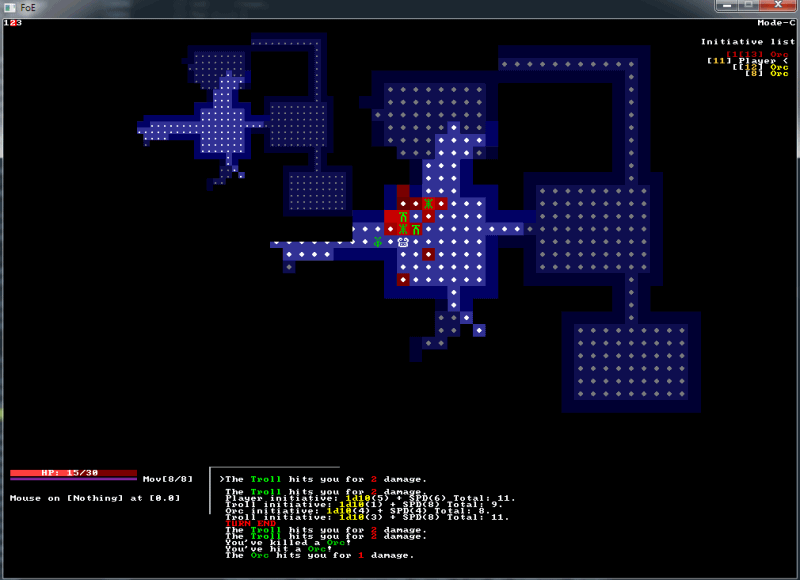I’ve taken a break from programming activities while also contemplating a possible split. The roguelike game on one side, and a reworked program that I could use simply to draw maps (even to use with old-school games that need mapping). Both of these need a programming component I still have zero knowledge about: how to read/write stuff to a file, so that I can save/reload (including the possibility to draw a dungeon instead of simply generating it randomly). I’ll get to it, eventually.
In the meantime I made a scheme of popular/classic JRPGs. Leaving aside the most recent entries on consoles. All the stuff in the chart can be emulated well on PC, so this is a list done for long-term preservation of these games, even if their respective hardware goes obsolete. The first number is the vote the game has on Gamefaqs (the site with enough votes to make them relevant), the next two numbers represent “hours of gameplay”, giving an idea about how long on average each game requires to complete (goes from main story to main story + some extras), and the last number is the number of votes, useful to consider how popular the game is.

Then I considered the mad plan of playing all Dragon Quest games in their order. I like setting up similar Epic tasks. They can range across all media. Like burning through the Battlestar series (I did this in December) or all five seasons + movies of Babylon 5, reading the whole Solar Cycle by Gene Wolfe, or all the ten Thomas Covenant by Donaldson, or the Dune cycle by Herbert (or Malazan, obviously), play the whole Shin Megami Tensei series across the various titles, read the HUGE, continuous storyline that unified all Marvel comics from 2004 to 2010 (starts with Avengers Disassembled), read the DC-side of Epic task, all the Crisis starting from the first, including all tie-ins (like 52), or reading the Morrison epic long cycle on Batman, play the Amberstar/Ambermoon epic duology of games on the Amiga (or the insane “Fate: Gates of Dawn”), or play World of Xeen, or Wizardry VII on PC, read Infinite Jest or Gravity’s Rainbow, watch all movies by Charlie Kaufman, study the Kabbalah (without spending one dollar), read the Chinese Epics like Three Kingdoms, or the five-volumes set of Dream of the Red Chamber (or the Japanese The Tale of Genji, or the Chinese erotic Jin Ping Mei, also in five volumes), or the historical 14 book cycle by Dorothy Dunnett, watch the critically acclaimed samurai trilogy of movies by Yoji Yamada (The Twilight Samurai, The Hidden Blade, Love and Honor, for a total of 6 hours and 20 minutes), watch or read all Once Piece, read Berserk, Eden, watch all Gundam and Macross series, or all Evangelion, watch all Haruhi Suzumiya in chronological order, learn to play the most hardcore wargames, watch all Kamen Rider series, watch in order the whole mytharc of X-files, or rewatch all Twin Peaks, or watch all Buffy, or Frasier, play/read the Nasuverse (includes Kara No Kyoukai series of seven animated movies), or the Muv-Luv series, or all of Umineko (80+ hours of “reading” on average), or better, first Higurashi and then Umineko, read all Sandman, play the Arkania trilogy of RPGs. And do not think this is even close to a complete list, I just got tired of adding stuff as I remember it.
Or study a programming language from zero and write a roguelike that consolidates 20 years of gaming in one game… All this just to say I enjoy setting up gargantuan, long-term tasks, and that’s way it’s absolutely required that I’m granted more than one life in order to do all I’ve planned. Just a reminder.
So last added to the list is playing these Dragon Quest games in sequence. The first three can be played on a SNES emulator and available in English thanks to some fan translations. The following three (4-5-6) make their own trilogy and re-released on the Nintendo DS, the 7th (probably the longest JRPG in existence) is on Playstation 1, the 8th on the PS2, and the 9th back on DS.
Putting some hours into Dragon Quest 1 has been quite interesting, and rather useful in the perspective of my roguelike. Playing old western RPGs is usually more annoying due to technical problems, glitches and general lack of ease of play, whereas the old JRPGs are technically “flawless” and essentially impossible to improve. The only difference with the modern ones is that their design is “scaled down”. And this makes them extremely interesting because it’s like seeing the building blocks directly. All following generations of JRPGs are simply about dressing up and adding parts.
Dragon Quest 1 plays flawlessly and is at the same time elegant and simplistic. There’s no party, just a single character to manage, you are given a bland mission, exit the first castle made of an handful of rooms, and are already on your own. The basic formula of the game is built as an economic system. Most of the game is played right on the world map, divided into zones, where you fight random encounters while you gravitate around towns. The most important “currency” the economic system is based on is the Hit Points. The more random encounters you go through, the more HPs go down, obviously. If you have Magic Points and an Heal spell then you can restore the HPs, but they are just two layers of the same thing, since sooner or later you’ll be out of MPs as well. The only way to restore both is to sleep at an Inn, and so go back to a village. During the fights on the world map you gain Gold, and with Gold you buy better equipment, pay the Inn, buy health potions. The difficulty and gameplay rises from the tension that is created by the need to be able to backtrack to a village (where you can restock), and the need to explore the world, so reach the next village, or go through a dungeon.
It’s actually extremely easy to find oneself in a bad situation because those random encounters are extremely frequent and in order to reach the places you are meant to reach you have to travel far away from the safety of a town. This means you could frequently realize you’re deep in a dungeon, lost (because dungeons are hard to navigate and the visibility extremely limited) and not likely to be able to backtrack quickly enough to a village. This economic system based on dwindling resources and the need to push further to reach a goal or find a new town instead of going all the way back comprises all gameplay the game offers. In villages you find a number of NPCs you can talk to, but they mostly offer a couple of lines of “flavor text”, or some bland lore, or tips. But you don’t have choices or quests being offered. The story doesn’t go beyond the classic “save the princess, kill the bad guy”. So what remains is going through the virtual tiers, leveling up to increase the HPs and MPs, gain enough gold to improve the equipment, which means being able to travel further away, so entering more dangerous areas that obviously scale along the player’s own progress. Eventually you’ll find a village where you can get special keys that open special doors in some dungeons. This is Dragon Quest 1.
What’s interesting for me is that I could implement all of this, almost an exact copy, with my current programming skills in my roguelike. I could make an exact copy of this game because the mechanics are straightforward and easy to grasp. This is already a skeleton of a game. When it works you have a structure and the rest of the work is about adding detail and depth. Seeing it work as a simple economic system reveals what truly makes the totality of the game. What you play with. The rest is flavor and dressing up.
When you plan and write a roguelike you have millions of ideas and complex things you want to do. But planning this from the top down makes it look utterly IMPOSSIBLE to achieve, and discouraging. Instead if you look at it from the bottom up, then it will be revealed as simple and linear. You need to know where things are coming from, dig in the archaeology of games to understand how things worked, and then you can quickly ascend to reach those places that are in your goals.
I’m only a few hours into Dragon Quest but it was a revelatory and constructive experience. At some point I couldn’t believe what I was seeing on screen:

I mean, finding a girl at a public bath that offers a “puff puff” for 20 gold? I had to search online to confirm my suspicion… And yeah, it’s more or less how it looks. This thankfully preserved by the fan patch, since the original Dragon Warrior games in the west had that dialogue cut. You don’t want kids asking their parents what’s a “puff puff”. I would have missed one famous and recurring gag of the Dragon Quest games ;)
By the way, I choose “Yes”. I got a puff puff, and wasted my 20 gold. Then I did it again.



